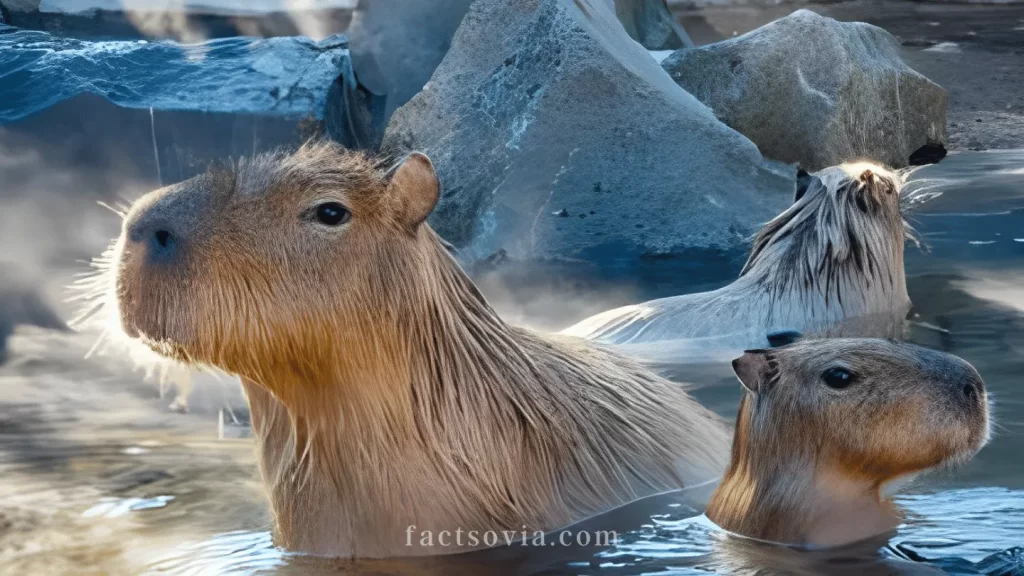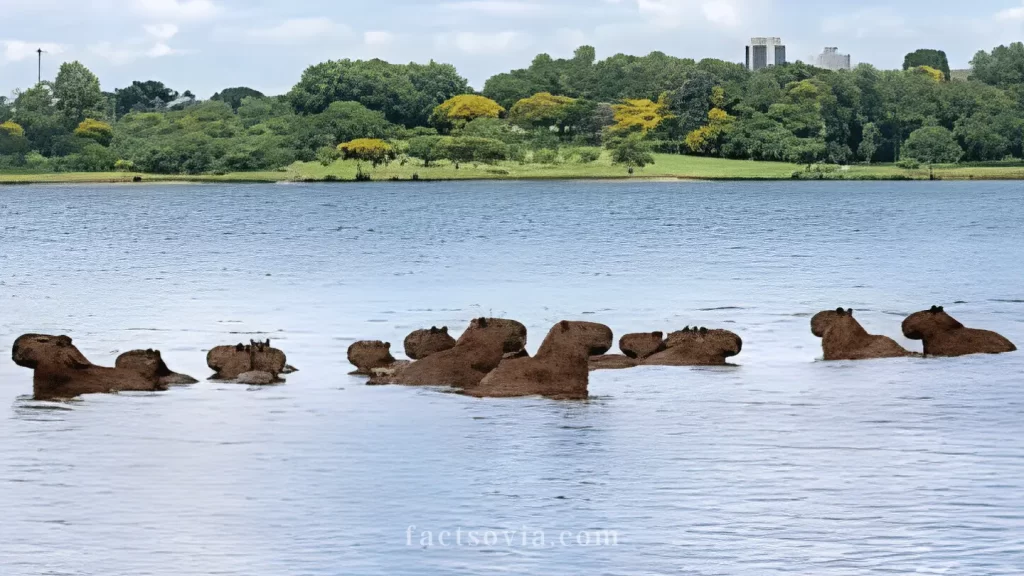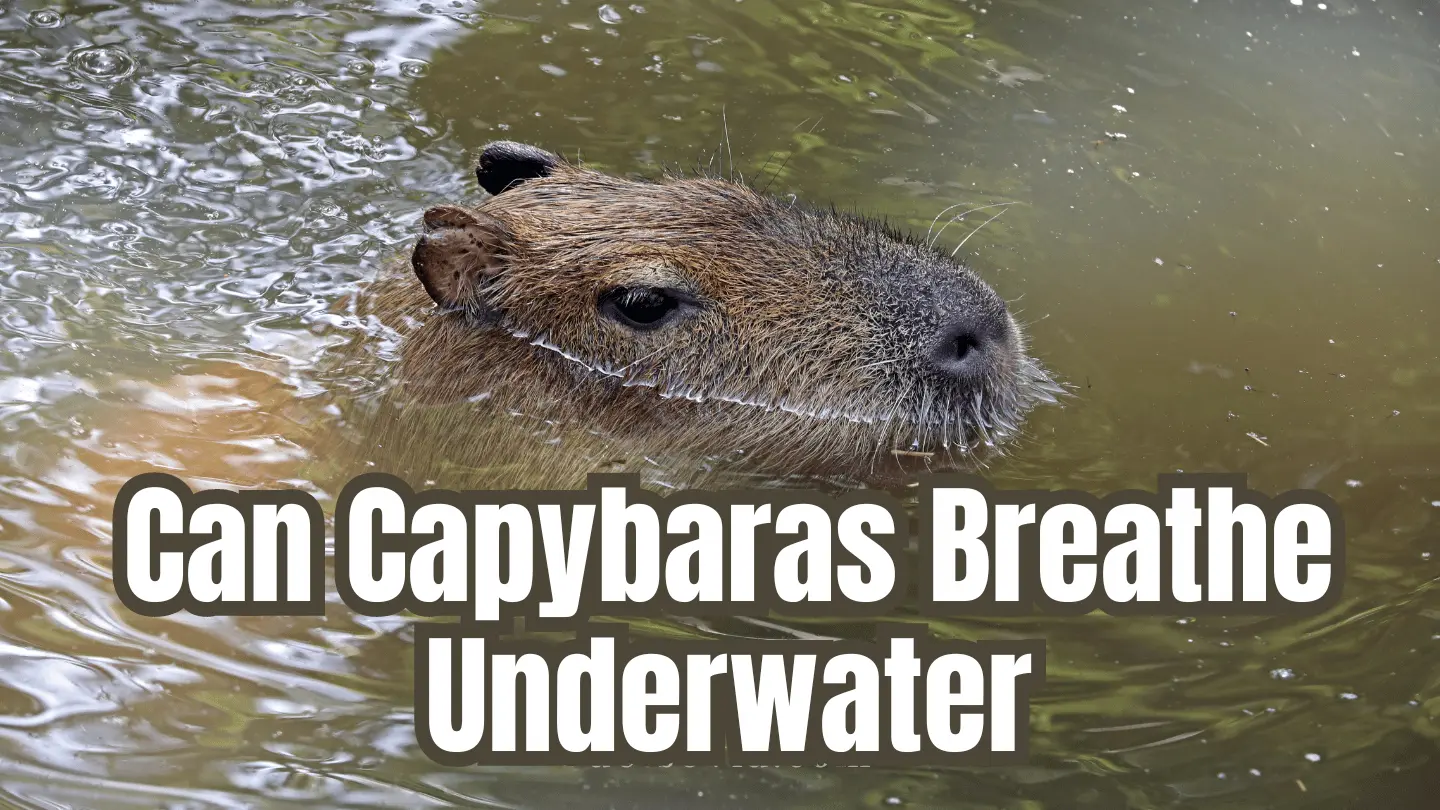We use affiliate links to run our site. When you buy through links on our site, we may earn an affiliate commission, without any added cost to you. Learn more
The capybara is the world’s largest living rodent, native to South America. Weighing up to 66kg, these highly social herbivores inhabit regions close to bodies of water such as lakes, rivers, swamps, and marshes.
Capybaras spend much of their time immersed in water and possess unique adaptations that allow them to dive and swim with ease. Their aquatic lifestyle means they have developed excellent breath-holding capabilities, specialized respiratory systems, and efficient means of underwater movement.
This article will provide a comprehensive look at the capybara’s anatomy and behavior that permit their versatile amphibious existence. We delve into exactly how long they can stay submerged, how they breathe, their swimming techniques, and underwater activities.
Let’s dive deeper into the captivating aquatic abilities of these unusual semi-aquatic creatures.
Respiratory Adaptations of A Capybara:
Capybaras have evolved an impressive respiratory system tailored to their frequent diving and swimming habits. Understanding their lung capacity and breathing rate sheds light on how capybaras withstand extensive stretches underwater.

Enhanced Lung Capacity
Despite their size, a capybara’s lungs can hold a remarkable 1.3 liters of air. Compared to the average human capacity of 6 liters, the capybara’s lung size is well-adapted to their smaller frame, permitting substantial oxygen storage per inhalation.
Before diving, capybaras deliberately take deep breaths, packing their respiratory tracts with ample air to sustain them while submerged. Their expansive lung volume gives them an enhanced reservoir of oxygen to tap into.
Slow Metabolic Rate
Capybaras also have an exceptionally slow breathing rate, averaging only 15 breaths per minute compared to a human’s 12-20. Their reduced respiratory rate allows capybaras to use up oxygen gradually, permitting them to manage longer periods without needing to resurface for air.
Coupled with their sizable lung capacity, capybaras have a thrifty oxygen usage that enables them to extract the most out of each breath. These respiratory adaptations allow the capybara to optimize its breath-holding potential and make the most of its diving ability.
How Capybaras Hold Their Breath:

Capitalizing on their specialized respiratory traits, capybaras can remain underwater for remarkably long stretches of up to 5 minutes. Exact dive durations vary, but their incredible breath-holding capabilities grant them ample time to navigate their aquatic environs.
Nostril Control
To aid extended submersion, capybaras have the ability to seal their nostrils shut. This prevents any water from entering their nasal airways, protecting their stored oxygen supply. The nostril control allows unimpeded breath-holding underwater.
Slow Metabolism
Their characteristically lethargic metabolism also assists breath retention, as less oxygen is consumed by bodily processes while diving. This metabolic adaptation gives capybaras better mileage out of their air supply during prolonged dives.
Foraging Benefits
The capybara’s exceptional breath-holding skills bring foraging advantages. They can scour aquatic vegetation without regularly needing to surface, granting them an efficient feeding strategy. Capybaras also utilize their diving ability to access choice water plants and grasses.
Thermoregulation
Capybaras harness their breath-holding power to cool down on hot days by lounging in water bodies. Remaining immersed for stretches helps regulate their temperature, using water’s higher heat capacity for relief from high ambient temperatures.
Predator Evasion
Hiding from predators is also facilitated by their diving prowess. By hunkering underwater out of sight, capybaras can evade threats on land and employ their extended breath retention as a survival tactic.
Their amphibious nature, coupled with specialized respiratory and diving techniques, allows capybaras greater security in their waterside habitats against hungry predators.
Aquatic Lifestyle & Behavior
Capybaras flourish in riparian regions and water bodies due to their adaptations for an aquatic lifestyle. Exploring their impressive swimming abilities and social underwater activities reveals fascinating insights about these unusual wild rodents.
Swimming Techniques
Owing to their streamlined build, webbed feet, and partial flippers, capybaras are agile swimmers adept at navigating their watery haunts. Front feet are used to paddle, while back legs provide propulsion. Their water-resistant fur and nose/eye position at the top of the head give excellent visibility while swimming mostly submerged.
Capybaras display graceful synchronized motions like aquatic dancers, gliding seamlessly across their wetland homes. Young capys especially delight in frolicking amphibiously during play. Their adaptation to an aquatic lifestyle affords them a refuge, food source, and place to socialize in water.
Underwater capybara facts
While underwater, capybaras continue to communicate and bond socially. They issue various whistles and vocalizations to convene with fellow capys in a practice dubbed ‘singing under water’.
Capybaras also form cohesive social ‘raft’ groups, huddling snugly together while floating or swimming in unison. These raft clusters can contain upwards of 100 individuals! Close physical intimacy fortifies social bonding among these highly gregarious creatures.
Dominance Hierarchies
Playful aggression like chasing or nibbling also occurs underwater as juvenile capys establish dominance rankings in their social collectives. Their underwater play fights determine each capybara’s standing in the group’s hierarchy. Females assume the alpha female role.
Grooming Rituals
Capybaras practice oral grooming rituals underwater too, patiently picking debris from each other’s fur and removing parasites like ticks lodged on the skin. Their fastidious grooming strengthens affiliative ties between Capybara raft members.
Regulate Body Temperature
To manage high temperatures, capybaras routinely take cooling dips by lounging in water bodies while keeping their heads aloft to breathe. By submerging all but their head, capys can restfully regulate their core body temperature.
Their adaptable lifestyle, ease in water, and array of swimming techniques enable capybaras to thrive in their favored riparian habitats across South America’s wetlands, lakes, rivers, and marshes.
Comparisons With Other Species
While capybaras share semi-aquatic tendencies with similar water-loving creatures, they possess their own unique qualities. We contrast them to beavers and otters to underscore key differences.
Capybara vs Beaver:
Both capybaras and beavers inhabit water margins, yet distinct variations occur between these aquatic rodents regarding habitat range, diet, construction behavior, and social dynamics.
Beavers engineer stick/mud dams transforming environments to alter waterways, whereas capybaras don’t manipulate habitat or build structures, instead relying on large group numbers for safety. Capybaras also consume more varied vegetative matter like fruits.
Capybara vs Otter:
In swimming adeptness and breath control, river otters edge out capybaras. Otters boast superior diving depths reaching 60 feet, outpacing the average 5-foot depths capybaras plunge to. Otters can hold their breath between 4-8 minutes, longer than the capybara’s 5 minutes.
Capybara swimming relies more on paddle power and its shape reducing drag as an energy efficient swimmer. Otters in turn excel in agility and speed, executing nimble somersaults and changing direction rapidly aided by a lengthy, muscular tail.
While not matching otters in hydrodynamic streamlining, capybaras make up for their larger size, wider diet breadth including aquatic plants, and complex social structure.
Conclusion
Capybaras have developed an outstanding capacity for amphibious living thanks to specialized adaptations for an aquatic lifestyle. From lung enhancements to nostrils that close, they display evolutionary ingenuity in exploiting their watery habitat.
Their diving abilities allow extended stretches underwater to forage, regulate temperature, bond socially, and evade predators. Capybaras have earned their reputation as skilled swimmers and divers, deserving of esteemed status as South America’s giant water rodents.
FAQs
How long can capybaras remain submerged?
Capybaras can hold their breath underwater for a maximum of around 5 minutes. Their specialized lung capacity, slow metabolic rate, and ability to seal nostrils permit this extended diving duration.
Do capybaras sleep underwater?
Yes, capybaras can sleep underwater by positioning just their nostrils at the water’s surface. This allows them to breathe while the rest of their body stays submerged. Their hydrodynamic form and diving skills let capys slumber aquatic-style!
Can capybaras breathe underwater?
No, like all mammals, capybaras cannot breathe underwater as they do not possess gills and require oxygen from the air. However, capybaras can hold their breath for up to 5 minutes aided by adaptations like large lungs, metabolic control, and sealed nostrils to minimize water entry.
Amazon and the Amazon logo are trademarks of Amazon.com, Inc, or its affiliates.
